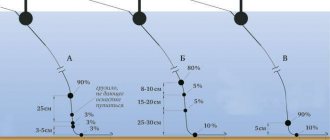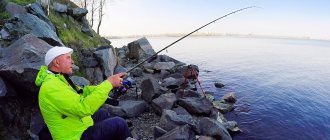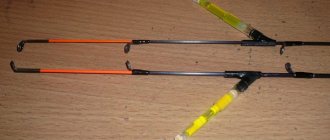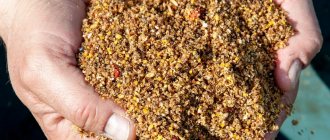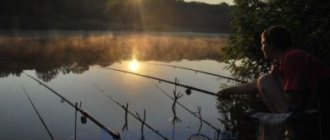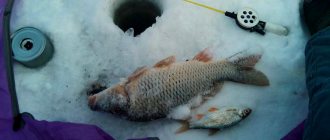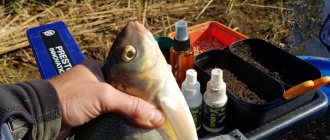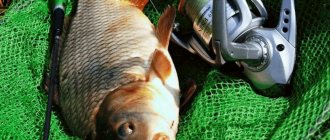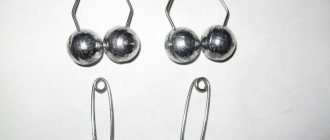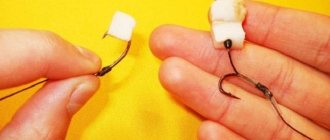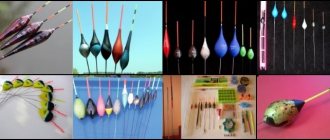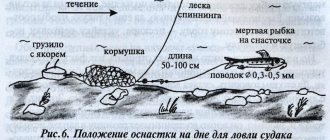Yuri 11/12/2020 700
The lower reaches of the Volga are interesting because many fishermen go to Astrakhan from the far corners of Russia in search of carp. The Volga reservoirs will make your carp dream come true; all you have to do is follow certain fishing principles and the advice of local rangers. Today we will analyze a tricky tackle for carp - a ring.
This shy and cautious fish is wary of open space and goes deep into holes and snags in search of food. The carp does not give up when fishing, resists, pulls away the gear, bends the rod so that you can hear their crackling, unbends the hooks and breaks the fishing line. Wild carp is considered a real fighter, even despite its unimpressive size. In autumn, especially in October, fishing for carp in Astrakhan is an exciting adventure.
Where to look for carp on the river
A large representative of the freshwater ichthyofauna, as befits a serious fish, loves spacious water areas.
Most often, carp lives in medium and large rivers, as well as in reservoirs formed by these water arteries. The habitat of the wild ancestor of the carp is quite extensive. It is found in the basins of the Black and Caspian seas, water areas of the Azov and Aral seas. Carp is found in Far Eastern rivers flowing into the Pacific Ocean, as well as in Lake Issyk-Kul. Carp is quite demanding on water quality, for example, the oxygen content must exceed 7 mg/l. This fish also loves warm water, so you can hunt for a trophy only during the open water season.1.
In spring, fishing for carp on rivers begins before spawning. During this period, the fish is already recovering from winter and begins to regain its strength. As soon as the water temperature approaches 15°C, the fish, as if on command, enter shallow bays rich in dead vegetation. For mating games, this large representative of the carp family chooses the coastal waters that are most overgrown with grass.
In the middle zone, spawning begins at the end of April or in May, which depends on the vagaries of the weather. Beginner fishermen are especially excited on a quiet evening, when large individuals begin to frolic near the shore. When you see such prey, your hands involuntarily grab the landing net. This is important! However, trying to catch fish in this way is futile and despicable.
After all, only one female is capable of laying up to 1.5 million eggs, some of which can subsequently turn into giant fish.2. In summer, the carp becomes more capricious; it switches to plant food, gnawing large quantities of young shoots of aquatic plants. On hot days, the fish hides in snags, under steep banks or at great depths.
It becomes impossible to get there without a boat.3. Autumn is considered one of the best times of the year for hunting wild carp. Starting from mid-September, the fish switches to active feeding. Gradually moving towards wintering areas, a natural concentration of a large number of carp occurs. During the feeding season, confident bites follow one after another. Even with cliffs and noisy fishing, the remaining members of the flock do not leave the feeding place, greedily absorbing both groundbait and bait.
What types of equipment are used
The equipment for carp, and in particular its formation and principle of operation, depend on a number of factors arising from the physiological characteristics of the fish, its habitat and preferences in the choice of nutritional objects. It is worth noting that carp are quite powerful and fast fish, capable of crushing even the most reliable tackle with poor handling technique. At the same time, the fish is very careful and timid, which is why it tries to stay at long distances from coastlines.
The carp prefers to inhabit snags and driftwood, as well as bottom topography with holes, adhering to moderate currents. It feeds mainly on muddy bottoms, as well as on shell rocks and shallow waters with young aquatic growth. The food supply consists of plant and animal food. The plant diet includes cereal seeds, as well as berries that fall into the water. Carp love young shoots of cattails and reeds.
Animal food consists of all kinds of insect larvae developing in the water, as well as mayflies, mollusks, especially zebra mussels, leeches, molting crayfish, fish eggs and the juvenile fish themselves. The use of high reliability parameters for tackle cords is greatly influenced by the presence of a file on the front ray of the upper fin of the fish, which often causes cut-offs of equipment when fighting hooked fish.
Based on all the features presented above, carp fishing relies on bottom rigs for long-distance fishing strategies and float rods, mainly fly rods, if fishing is planned to be done from a boat or a cliff hanging over a reservoir. Fishermen use both universal purchased and homemade gear, tailored specifically for carp.
Feeder tackle
The feeder belongs to the bottom type of equipment, combining two important features that help catch carp - the ability to fish at long distances, over 100 meters, while simultaneously forming a feeding table that attracts fish. The feeder fishing rod for carp is distinguished by a length parameter starting from 3.5 meters and above, as well as a large dough, selected from 80 grams. The medium action of the blank, shifted towards the slow one, helps to effectively fight with already caught fish and notice its careful bite.
A spinning reel is selected under the rod with the obligatory presence of a baitrunner and a safety cable on the butt of the tackle. The device size is at least 3500–4000 units. The spool should hold about 200 meters of 0.25 mm braided cord. The power and traction mechanism covers the harsh conditions of carp fishing.
Shock leaders and ties are used in the rigging of the lines, allowing you to feel subtle bites in current conditions. The use of feeders varies from classic metal or plastic meshes to method and spring options. A thin braided leash with a length of 20 to 40 cm is placed on the feeder, equipped with a hook number 8–10.
We invite you to familiarize yourself with Zucchini caviar - recipes with photos on Povar.ru (146 recipes for zucchini caviar)
Bottom gear for catching large carp is assembled according to the principle of carp equipment, which is based on replacing the feeder with a blind sinker, which allows the fish that takes the bait to self-hook. Such installations are completed on specialized carp rods or spinning rods with large tests. The rod is equipped with carp low-speed spinning reels equipped with a braided cord having a high breaking load.
Often, in this type of equipment, hair equipment is used, when installing gear for fishing with corn or boilies. When a fish tries the bait, it hooks itself. The bite is controlled by various signaling devices based on the principle of operation. The signaling device can be either a regular bell or an electronic light and sound system with a pager. Carp equipment is convenient for fishing with several rods at the same time at any time of the day.
Equipment for catching carp in the current should hold the bait in the bottom layer. The river piglet sucks up food from the bottom with its mouth, like a vacuum cleaner. Sometimes a fish manages to dig up a shell hidden in the ground up to 20 cm deep. However, when installing equipment, you should not focus on sensitivity and elegance.
Only the strength of the structure will be the main criterion during installation.• Of the many feeder equipment, you should choose the paternoster. The design is based on the main fishing line, it is simple and quick to do. First, a swivel with a snap hook is attached to the main fishing line. Then, measuring 30-40 cm from the end, the thread is folded in half.
The swivel should be on the resulting loop. A surgical loop is made 10-15 cm from the swivel. At the resulting end of the 20-25 cm fishing line, a knotted loop is knitted, to which the leash will be attached. A feeder is attached to the carabiner while fishing. In the case of a side fishing rod, instead of a feeder, a sinker with a flat shape is mounted.
• “Nipple” is a feeder to which leashes with hooks (3-4 pcs.) are attached. The “nipple” can be made of polyethylene cork, wire twisted into a spring, concave lead plates, etc. Most often, leashes are made of soft fishing line or braid. Any model No. 5-8 is suitable as a hook for carp.
• “Makushatnik” is a tool that is adjusted to fit rectangular pressed sunflower cake. The basis of the “makushatnik” is a lead plate or casting, the dimensions of which are comparable to a matchbox. Holes are made in the corners of the plate for mounting leads. Before laying the pressed cube, transverse and end cuts are made on it.
A longitudinal slot is needed for tying to a sinker with a thread, and hooks are hidden in the end grooves. • There is also no point in making too elegant equipment for a float fishing rod. A large carp in an instant drags the float under the water. For fishing from a boat, it is enough to choose a river float model with a carrying capacity of 3-5 g.
A sinker weighing 3-5 g is mounted on the main fishing line. It should completely submerge the body of the float. A feeder in the form of a pellet of 0.2-0.5 g is attached to a leash. During retrieval, the fisherman must cling to the bottom, slowing down the floating bait. To hunt for freshwater piglet, the fisherman has a fairly wide choice of fishing methods.
Principles of fishing from shore and boat
Depending on the habitat of the carp, the time of year, and the size of the reservoir, a suitable fishing method is selected. And a fishing rod, equipment and bait are prepared for it. In spring and autumn, when the fish comes close enough to the coastline in search of food, you can purposefully hunt for wild carp from the shore. The success of fishing will depend on several factors. Recommendation!
Carp is a cautious and cunning fish. If the fisherman makes noise on the shore, he will never see a bite.• Local fishermen who have the opportunity to regularly visit the river begin fishing by hooking wild carp. Since even one large representative is capable of destroying a large volume of food, a 5-10-liter bucket of food is usually sent to the selected location.
It is clear that if you buy bait in a store, you can ruin all the local fishermen in a couple of months. Therefore, the river pig is accustomed to simple and cheap village food. In some regions where agricultural enterprises specialize in corn, they are accustomed to bright yellow grains. Other anglers stock up on whole peas in the fall.
Some outdoor enthusiasts generously treat carp with wheat or pearl barley. Because of this attraction, many urban fishermen are not able to compete with local fishermen, even surpassing them in equipment, gear and range of baits.• Far from populated areas, it takes several hours to attract wild carp.
We suggest you read: Can the body overcome mouse fever on its own? Symptoms of mouse fever in adults and children.
To do this, it is not enough to throw in cooked corn or peas. To attract large fish from distant parts of the river, you need to create a trail of fragrant turbidity. Only in this case can you hope to get a bite from a river pig. • Fishing from a boat has an important advantage over coastal fishing.
It is enough to find a fish site in order to quietly approach it within casting distance of a fishing rod. A little bait dropped into the water will immediately have an alluring effect on wild carp. Of course, we must not forget about camouflage in a boat. It is enough to drop a heavy object to the bottom of a wooden or metal boat, and the fish will leave the baited section of the river.
Selecting a location
To choose a good place for fishing, you need to arrive at the reservoir in advance, preferably before dawn.
In the early morning, the carp often appears in shallow water; it can enter bays and swim along the edge of the reeds. At the same time, the carp loves to play, jump out of the water, and the splashes of large fish on the surface are easy to notice and especially hear in the pre-dawn silence. If a fisherman is lucky enough to notice the game of a carp, he can, by studying the surroundings and the nature of the bottom using a pole or echo sounder, very accurately determine the boundaries of the territory where the carp lives. But even if this was not possible, based on a number of signs you can find a place where the probability of catching carp will be quite high.
First of all, you need to focus on changes in depth, holes and pools - typical habitats of carp. It can be found at the bends of a river with a sharply descending muddy bottom or a reverse flow. Nearby thickets of reeds, algae or snags are another sign of the carp’s habitat: the fish go there to feed.
A steep bank with trees and reed thickets hanging over the water may also be suitable as a fishing spot, but only if the depth there is at least 2-3 meters or more. Despite the fact that carp prefers quiet places, it makes sense to catch it in a strong current.
Firstly, it is usually quite deep there, and secondly, when using feeder equipment, the current carries the bait, and thus increases the chances of attracting fish to the bait site.
As a rule, places that meet all the listed requirements turn out to be less convenient for the fisherman himself. Using a feeder rig gives the fisherman more freedom of movement along the shore, but when fishing with a rod, he is very limited in his choice.
There is a chance to attract the carp to a more convenient place only if there is no strong current that will carry away the bait. However, the wait may take too long or even be in vain. Therefore, to successfully catch carp using a fishing rod, it is preferable to choose a place not according to your own taste, but to focus on the signs listed above.
How to make tackle for carp with your own hands
It is easy to assemble the tackle for carp yourself from common fishing accessories; besides, by individually completing the equipment, the angler will be able to take into account the nuances necessary for fishing for the specifics of the chosen place and the planned size of the trophy in the catch. As we have already mentioned, the algorithm itself for sets of bottom and float tackle is similar to the classic assembly of devices for most types of carp fish, the only differences are in their parameters of increased reliability and high breaking load of the cords. In continuation of the article, we will focus on the most popular types of making and assembling carp tackle with our own hands.
Float rod
Fishing tackle for carp, based on a fly rod, is used for fishing at short distances from shorelines over ledges and from cliffs above the water, as well as from swimming devices. More convenient are water areas with low current strength, backwaters and creeks in shallow waters, where carp are suitable for searching for food.
The main line is taken with a diameter of at least 0.3 mm. The float is of a spindle-shaped type, no heavier than 3 grams. The lower part of the float should be painted in discreet colors close in shades to the color of the water, which is not so alarming to shy fish. The load is distributed along the fishing line in the form of a garland that decreases in weight towards the leash.
The bait for carp is formed on a slow action spinning rod with weights of 40–80 grams. The length of such a rod should be within 3-3.5 meters, which will guarantee the possibility of long-distance casting. The spinning rod is equipped with a power spinning reel with a baitrunner and a gear ratio of up to 3.5-4.5 units.
The main cord is taken to be braided, which transmits bites from long distances much more effectively. The installation itself may vary in its options, including a combined blind weight in the form of a feeder or a classic weight with a fastening loop. The leashes are knitted from thin braids, up to 0.15 mm thick, painted in discreet color tones similar in color to the silty or clayey bottoms being fished.
The length of the leash should not exceed 40 cm, based on the principle that the more active the fish, the shorter the leash. After casting, the bottom tackle is installed on a stand on the shore and equipped with an audible alarm, and is necessarily secured by attaching it to a cable that prevents the fish from pulling the cast into the water.
Makushatnik
One of the catching gear for catching carp is considered to be equipment using a macaque. Pieces of pressed cake from sunflower seeds are attached to a special flat-looking platform - a sinker, which is made in the shape of a dovetail and has devices for rigid installation of the bait.
In the bait itself, in its corners and the center of the upper edges, there are holes where the hook is mounted. Usually, for carp hunting, four to six hooks are placed on the top of the head. The hooks are tied onto monofilament leashes with a diameter of 0.25-0.30 mm, the length of which does not exceed 7–10 cm. The leashes are attached to the platform in special mounting holes.
Depending on the strength of the current in the fished area, the mass of the platform is selected, which should not be moved by the stream when set up. Typically, the weight of this combination sinker is in the mass range from 80 to 160 grams. To cast a rig with a spinner, use a feeder rod or a mid-standing spinning rod.
Match fishing rod
At long distances, in addition to using donks with a feeder, anglers successfully use the method of catching carp using a match fishing rod. When fishing for this powerful fish, choose fast match gear 4-4.5 meters long with the highest test in this class. The fishing rod is equipped with a spinning reel with a finely adjustable clutch, 3500–4000 units in size.
We invite you to familiarize yourself with Sazan pieces in the oven with potatoes
This tackle for fishing from the shore has a number of nuances in the fishing technique that relate to the specifics of catching carp. In particular, anglers never clip the line to fix the casting distance, since when fishing, the fish can take a significant part of the line, which will lead to a break in the installation when installing the line in the clip. In addition, when hooking a trophy, it is pumped out by the joint work of the rod and reel without forcing it with accelerated reeling.
Spring
A tackle with a spring-shaped feeder is effective in catching carp. The hunting method is based on feeding the feeder into the fishing zone, into which hooks are embedded that catch the trophy, sucking the bait from the spring. Hooks can be either with attachments in the form of foam balls or hair rigs with boilies or empty, which depends on the preferences and activity of the fish.
Spring feeders for carp are loaded with bread, sweetened pearl barley or millet porridge. Two or three hooks are placed on one feeder on monofilament leashes no longer than 5–7 cm and 0.20–0.25 mm thick. In some fishing conditions, anglers use a garland of spring feeders, sequentially mounted on one cord in the amount of 2-3 pieces.
As in the method of using a rig with a top rod, feeder and spinning rods with similar operating parameters are suitable for fishing. The rods are equipped with sound alarms that are triggered when a hooked fish catches itself. The fishing itself can be carried out around the clock, and this method is especially successful during the stabilization of intense heat during the day, in the middle of summer.
River fishing gear
Whatever tackle an angler chooses for catching carp, it must be extremely durable and reliable. When assembling a fishing rod, it is necessary to carefully make knot connections, check the integrity of the fishing line and leash, and carefully inspect the hooks and swivels. Trophy fish does not forgive negligence and inattention.
If you can catch small carp with any float or bottom tackle, then when catching large fish, the range of suitable fishing rods is significantly reduced. For coastal fishing, you can select a feeder and traditional donks. You can successfully fish from a boat using an onboard or Bolognese fishing rod.1. Feeder tackle is in many ways similar to a carp fishing rod.
It includes a powerful feeder rod 3.6-3.9 m long with a test load of up to 120 g. A reel with a 3500-5000 spool must have a baitrunner. Otherwise, even a reliable stand will not prevent the loss of gear. A braided cord with a breaking force of up to 20 kg is suitable as the main fishing line. The equipment and leash are selected according to the fishing conditions.2.
Such traditional donks as “nipple” and “makushatnik” are considered primitive but effective. They are based on inexpensive fiberglass spinning rods about 3 m long. The rod is often equipped with an inexpensive but reliable Neva reel. Monofilament fishing line with a diameter of 0.5-0.8 mm is suitable as a base.
Leashes made of 0.3-0.5 mm fishing line are attached directly to special equipment for catching carp.3. A side fishing rod is an analogue of a feeder, only the rod is chosen to be short. Some fishermen attach a nod to the tip in order to see a bite before the carp begins its sprint swim. Since the bait is lowered near the boat in a large mesh feeder, the rig uses a sinker instead of a feeder.4.
The Bolognese fishing rod is in demand among ardent supporters of float fishing. The rod is equipped with an inertial reel that can rotate under the influence of the current. The equipment consists of a 0.4-0.5 mm monofilament line, a float, a sinker and a leash with a hook. Recommendation! The equipment must float exactly along the bait train. Then the fish will confidently grab the naturally floating bait.
Equipment for donkeys
They are not used in sport fishing. Today, fishermen use the following types of donkey equipment for carp:
Which is made using a feeder of the same name. It is secured to the fishing line using a rubber stopper or bead.
In this case, leashes with hooks approximately 7 cm long are placed at equal distances around the circumference of the spring.
It is a feeder with plasticine bait in which hooks are hidden.
Tackle for fishing from a boat
From boats they carry out targeted fishing for trophies in places that are difficult to reach for long-distance casting among snags and driftwood. Short fly rods with a length of 2.5 to 4 meters are used as onboard tackle, the form of which is equipped with pass-through rings and a small inertial reel for storing fishing line for reliability.
Fishing rods are equipped with both float rigs and rigs with feeders; the top and nipple are especially practical. A monofilament line 0.3 mm thick is sufficient as a cord. The short lengths of rigs for fishing in the current prevent a fish that takes the bait from quickly going into the snags and completely tangling the line. To select the fish to be caught, the boat must have a massive landing net.
Selection of gear for catching carp
Everyone decides for themselves what is more convenient to use when fishing, but still, if the goal is to catch carp, it is worth choosing equipment adapted for this.
Rod
For the basis of tackle intended for carp, the use of both a spinning rod and a fishing rod is effective. First of all, you should navigate the models taking into account the desired weight of the caught fish. Equipment should be purchased only of the highest quality from reputable places.
Don’t lose sight of fishermen’s recommendations and stories about already tested devices. This makes it easier to identify specific models that you should focus on.
When the fishing process is important, regardless of the result of the catch, simpler models are sufficient.
The optimal length of a plug rod ranges from 3 to 4 meters. Medium flexibility devices perform well. In this case, you don’t have to worry that the rod will break.
fishing line
The optimal fishing line diameter is from 0.27 to 0.35 mm. According to its physical characteristics, it must have high resistance and low extensibility. The low-stretch line behaves pliably in a contaminated place and does not break if it is necessary to free it from the snag.
The life of the fishing line in operation also plays a role. With each new use, its composition loses elements responsible for its physical characteristics, and at the most inopportune moment a rupture may occur. It is better to store fishing line at low temperatures.
Coil
First of all, you should choose a reel based on its strength and reliability, as well as whether it is equipped with a baitrunner system. This device allows you to quickly disable the coil stopper if necessary.
The need for such modification is determined by the strength and power of the desired prey. Also, the coil must meet a number of other important requirements:
- gear ratio from 4.1:1 to 4.8:1 (the slower the rotation, the easier it is to catch a large carp);
- spool from 4500, this size will allow you to make long casts and quickly reel in the gear;
- bearings from 5 pieces, they are responsible for the reliability and safety of the structure.
Feeder
The choice of feeder is influenced by the speed of the current at the fishing site. In still water or weak currents, a plastic option is sufficient. Do not forget that you should not use too much bait for it. If the current is strong, a lead feeder is suitable; it is both heavier and more reliable than a plastic one.
Hooks
Specialized hooks for carp are also produced. This species is commercially called “carp hooks.” These models are different in shape and size, but their main difference is the short forearm and rounded shape. These features do their job well.
When the fish takes the bait, the hook is located below and clings to the lower lip.
Only dark metal color is used for such hooks so as not to scare away fish in the water. As when choosing all the equipment for catching representatives of the carp family, we must not forget about the need to use only reliable and high-quality components of the gear.
How to catch more fish?
I have been active fishing for quite some time and have found many ways to improve the bite. And here are the most effective:
- Bite activator. Attracts fish in cold and warm water with the help of pheromones included in the composition and stimulates its appetite. It’s a pity that Rosprirodnadzor wants to impose a ban on its sale.
- More sensitive gear. Reviews and instructions for other types of gear can be found on the pages of my website.
- Lures using pheromones.
You can get the rest of the secrets of successful fishing for free by reading our other articles on the site.
